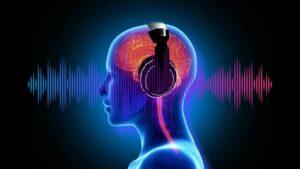Insomnia is a sleep disorder that affects millions of people worldwide, resulting in difficulty falling asleep, staying asleep, or experiencing restorative sleep. Chronic sleep deprivation can lead to severe physical and mental health issues. Traditional treatments for insomnia include cognitive-behavioral therapy, prescription medications, and lifestyle modifications. This comprehensive guide will delve into sound therapy as a treatment for insomnia, exploring its history, scientific basis, various techniques, and practical application.
Contents
What Is Sound Therapy?
Sound therapy is a natural treatment that uses different sounds to help people relax, lower stress, and improve their well-being. It works by using special sounds that can have a strong effect on our body, emotions, and mind. There are many types of sound therapy, such as:
- binaural beats
- nature sounds
- music therapy
People often use sound therapy to help with problems like insomnia, anxiety, and stress. This therapy offers a gentle, accessible, and personalized approach to enhancing overall wellness. And this makes it an appealing option for those seeking alternative methods to support their mental and emotional well-being.
Scientific Basis of Sound Therapy
 The scientific basis of sound therapy lies in the understanding of the brain’s response to auditory stimuli and its potential for inducing relaxation and positive physiological changes. Several key concepts underlie the effectiveness of sound therapy in promoting relaxation and alleviating insomnia.
The scientific basis of sound therapy lies in the understanding of the brain’s response to auditory stimuli and its potential for inducing relaxation and positive physiological changes. Several key concepts underlie the effectiveness of sound therapy in promoting relaxation and alleviating insomnia.
Brainwave Entrainment
Brainwave entrainment is a process in which the brain synchronizes its electrical activity to an external auditory stimulus. The brain exhibits different types of brainwaves depending on its current state. Such as being awake, asleep, or in deep relaxation.
By introducing an external auditory stimulus with a specific frequency, the brain can be encouraged to match its own frequency. This results in a shift in brainwave patterns. For insomnia, sound therapy aims to induce brainwave patterns associated with deep sleep, such as delta waves.
Auditory Driving
Auditory driving is a phenomenon in which rhythmic sound patterns can influence the brain’s electrical activity. The brain responds to repetitive auditory stimuli by synchronizing its neural oscillations to the rhythm of the sound. This synchronization can lead to altered states of consciousness. Such as relaxation or trance-like states, which can be beneficial for those with insomnia.
Autonomic Nervous System
The system (ANS) regulates the body’s unconscious processes, such as heart rate, respiration, and digestion. It is divided into two branches:
- sympathetic nervous system (SNS)
- parasympathetic nervous system (PNS)
The SNS is responsible for the “fight or flight” response, while the PNS is associated with the “rest and digest” response. It can help activate the PNS, promoting relaxation and reducing stress levels. This relaxation response can make it easier for individuals with insomnia to fall asleep and stay asleep throughout the night.
Distraction and Masking
Sound therapy can provide a distraction from racing thoughts, anxiety, and other stressors that may prevent sleep. By focusing on the sounds or music, individuals with insomnia can shift their attention away from these stressors, making it easier to relax and fall asleep.
Psychoacoustic Effects
It is the study of how humans perceive sound and the psychological effects it has on us. Certain sounds or combinations of sounds can evoke specific emotions or reactions. That can be leveraged in sound therapy to induce relaxation, calmness, or even sleepiness. For example, natural sounds like rain or ocean waves can create a sense of tranquility. While slow-tempo music with minimal changes in pitch and volume can promote relaxation and sleep.
Overall, the scientific basis of sound therapy for insomnia is rooted in the understanding of brainwave entrainment, auditory driving, the autonomic nervous system, distraction and masking, and psychoacoustic effects.
Different Techniques Used In Sound Therapy For Insomnia
 There are several sound therapy techniques, each technique has its unique approach to promoting relaxation and sleep. And each technique may vary depending on individual preferences and needs. A few of them are listed below:
There are several sound therapy techniques, each technique has its unique approach to promoting relaxation and sleep. And each technique may vary depending on individual preferences and needs. A few of them are listed below:
- Binaural Beats
Binaural beats are an auditory illusion created when two tones with slightly different frequencies are played separately into each ear. The brain perceives the difference in frequencies as a third, phantom beat. restorative sleep. To use binaural beats for insomnia, listen to recordings with frequencies targeting delta or theta waves through headphones. The beats can help induce a state of relaxation, making it easier to fall asleep.
- Isochronic Tones
Isochronic tones are single tones that are turned on and off at a specific interval, creating a rhythmic pulse. isochronic tones can be used to target specific brainwave frequencies and promote relaxation. That makes it easier to fall asleep and stay asleep. Unlike binaural beats, headphones are not required for isochronic tones. But they can enhance the experience.
- Pink Noise
Pink noise is a type of sound that has a consistent frequency distribution, with the intensity decreasing as the frequency increases. This creates a balanced, soothing sound. And that can be compared to the sound of rainfall or gentle waves. Pink noise has been shown to improve sleep quality by promoting relaxation and masking disruptive background noises.
- Nature Sounds
There are some nature sounds, such as rain, ocean waves, or birdsong, that can be used in therapy to promote relaxation and reduce stress. These sounds may help distract from negative thoughts. And often helps in creating a calming environment conducive to sleep. To use nature sounds for insomnia, listen to recordings of your favorite nature sounds. Experiment with different sounds to find what works best for you.
- Guided Meditations
There are recordings that provide verbal instructions to guide listeners through relaxation techniques, visualization exercises, or mindfulness practices. These meditations can help individuals with insomnia quiet their minds and release tension, making it easier to fall asleep.
Practical Application of Sound Therapy For Insomnia
Incorporating sound therapy into your daily routine can be an effective approach to managing insomnia. Here are some practical steps to apply sound therapy techniques for better sleep:
Choosing the Right Sound
The effectiveness of sound therapy for insomnia can depend on individual preferences and needs. Experiment with various techniques and types of sounds to determine what works best for you. Some people may respond better to binaural beats, while others might find nature sounds or guided meditations more effective. Keep an open mind and be patient. As it may take time to find the optimal sound for your sleep needs.
Establishing a Sleep Routine
Incorporate sound therapy into a consistent sleep routine to maximize its benefits. Engage in relaxing activities before bedtime. Such as reading, taking a warm bath, or practicing deep breathing exercises. Start the sound therapy session about 30 minutes before your desired sleep time to allow your body and mind to relax fully. Establishing a consistent bedtime and wake-up time can also help regulate your sleep cycle and improve sleep quality.
Creating a Sleep-Conducive Environment
Ensure your sleeping environment is comfortable and conducive to sleep. Maintain a cool, dark, and quiet bedroom, and invest in a comfortable mattress and pillows. Use blackout curtains or an eye mask to block out light and consider using earplugs if external noises are a concern. Introducing sound therapy in such an environment will further enhance its effectiveness in promoting relaxation and sleep.
Sound Therapy Devices and Apps
There are numerous devices and apps available to facilitate sound therapy for insomnia. Some popular options include:
- White noise machines: Devices that generate consistent white noise to mask external sounds and create soothing background noise.
- Pink noise generators: Similar to white noise machines but generate pink noise, which some people find more relaxing.
- Sleep headphones: There are some specialized headphones designed for comfort during sleep. It allows you to listen to your preferred sound therapy without disturbing your partner.
- Sleep apps: Many mobile apps offer a variety of sound therapy options. Some popular apps include Mantra Care.
What Are The Benefits You Can Expect?
 The following are numerous benefits you can expect with the therapy, particularly in the context of insomnia. These benefits include:
The following are numerous benefits you can expect with the therapy, particularly in the context of insomnia. These benefits include:
- Enhanced relaxation: Sound therapy helps calm the mind and body, making it easier to relax and prepare for sleep.
- Reduced stress and anxiety: By promoting relaxation and stimulating the release of endorphins, sound therapy can help alleviate stress and anxiety that may contribute to insomnia.
- Regulated sleep patterns: Consistent use of sound therapy can help establish and maintain healthy sleep routines, improving overall sleep quality.
- Masked environmental noise: Sound therapy, particularly white noise, and pink noise, can help mask external noises that may disrupt sleep, creating a more consistent and soothing auditory environment.
- Improved sleep quality: Various sound therapy techniques can enhance the amount and quality of deep, restorative sleep, contributing to more restful and rejuvenating sleep experiences.
- Non-pharmacological approach: Sound therapy offers a drug-free alternative to traditional insomnia treatments, helping individuals avoid potential side effects and dependency issues associated with prescription sleep aids.
- Personalization and flexibility: Finally, this therapy allows for customization and flexibility, enabling individuals to find the sounds and techniques that work best for their unique needs and preferences, leading to more effective outcomes in managing insomnia.
All in all, if you are choosing sound therapy for insomnia, this offers a wide range of benefits that can significantly improve sleep quality and overall well-being. This makes it a valuable and personalized tool for those seeking a natural and holistic approach to overcoming it.
Conclusion
In conclusion, sound therapy for insomnia offers a promising, non-pharmacological approach by harnessing the power of various sounds and techniques. By promoting relaxation, reducing stress, regulating sleep patterns, and creating a sleep-conducive environment, sound therapy can improve sleep quality. Also overall well-being for those affected by insomnia. By integrating sound therapy into daily routines and combining it with other complementary practices, individuals can develop a comprehensive, personalized approach to managing insomnia. And achieving a better night’s sleep.
For more information, please contact MantraCare. Sleep is an essential part of our daily routine and it plays a significant role in maintaining a healthy body and mind. If you have any queries regarding Online Insomnia Counseling experienced therapists at MantraCare can help: Book a trial therapy session


